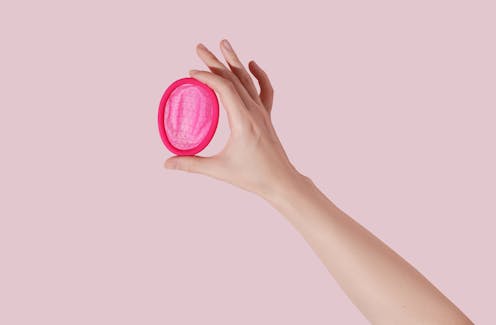
Heavy menstrual bleeding or heavy periods affect up to a quarter of women and people who menstruate, and can impact quality of life. Women who have had heavy periods for a long time often consider this normal, or something to be simply put up with.
Diagnosing heavy periods has traditionally been based on the nature of bleeding. Women might describe bleeding through clothing, having to change pads and tampons every two hours or sooner, or passing clots larger than a 50 cent coin. Doctors consider a woman to have heavy periods if she regularly loses more than 80 millilitres of blood during one menstrual period. That’s four Australian tablespoons’ worth. Women diagnosed with heavy bleeding should follow up with their doctor to establish the cause of their bleeding and guide treatment.
But estimating blood loss and getting a sense of when it’s outside the normal range can be difficult. Recent research on how best to manage menstrual blood could help.
Read more: Heavy periods are common. What can you do, and when should you seek help?
More period options than ever
There are now a variety of menstrual products for women to choose from.
These include disposable pads and tampons, as well as reusable products such as menstrual cups and discs, washable pads and period underwear. There are multiple factors which influence choice of menstrual product, including comfort, cost, capacity, environmental benefits and potential health risks.
A 2022 French survey of over 1,100 women showed traditional sanitary protection was still the most widely used there (81% used disposable pads and 46% used tampons) but 16% of respondents were using alternative products. A recent study in Victoria indicated many young people are choosing reusable products, with environmental impacts an important motivator.
Another benefit of reusable menstrual cups and menstrual discs is they can remain in the vagina for up to 12 hours. A menstrual cup sits in the vagina below the cervix and extends into the canal. A menstrual disc, on the other hand, fits back into the vaginal fornix, which is where your vaginal canal meets your cervix. Discs are usually wider and shallower than cups and can be worn during sex. There are now reusable and disposable options for menstrual discs.

Read more: Does anyone have a pad? TV is finally dismantling the period taboo
What holds the most blood?
There has been very limited research into the maximum capacity of different menstrual products. Manufacturers can report collection capacity of their products using liquids such as water.
A recent research study from the United States aimed to more accurately measure the capacity of menstrual products in the laboratory using expired donated human blood, which is more similar to menstrual blood.
Some 21 different menstrual products were tested in the study. Menstrual discs showed the greatest capacity (61ml on average) and period underwear held the least (2ml on average).
Tampons, pads, and menstrual cups held similar amounts of blood (approximately 20–50mL). The authors noted it is difficult to accurately approximate capacity for patients with heavy menstrual bleeding due to “flooding” (high-velocity flow) and passing clots.
The comparison shows period underwear, despite its advertised capacity, may actually only absorb a small amount of blood and very slowly. Women with heavy periods tend to use period underwear as “back up” for another method.
We need a standardised scale for menstrual bleeding
Currently, the ways to determine whether someone is having heavy menstrual bleeding is through asking detailed questions and using the Pictorial Blood Loss Assessment Chart, which relates to the saturation of menstrual pads and tampons.
The overall impact of the heaviness of menstrual bleeding on a woman’s quality of life is also important.
Even with pads and tampons, there is significant variability in terms of capacity. The introduction of newer products potentially introduces more confusion, with both users and clinicians uncertain about the storage capacity of each category of product, and specific brands within these categories.
With heavy menstrual bleeding often underdiagnosed and undertreated, clinicians need to ask specifically about the menstrual products used and how they are used to better understand a person’s bleeding patterns. The fresh US research could help women and their doctors better assess the heaviness of their periods.
Read more: Health Check: are painful periods normal?
3 tips for managing heavy flow
1. Experiment with period products. It may be good to try out different types of products (and even different products in the same category) to find the ones that suit you best. The advertised capacity of each product may not ring true with your own experience, due to the nature of your flow (particularly if it is heavy or “gushes”).
2. Monitor the heaviness of your period. The capacity of different menstrual products varies widely. Menstrual discs have very high storage capacity in comparison to other products. That can actually lead to an underestimation of menstrual loss. Looking up the storage capacity of each product can help you work out whether you are having heavy periods or not, even though we know this may be based on liquids like water. This information can be found on the product website or the new study.
3. When to seek medical advice. If you think you might be having heavy periods, feel tired or dizzy during your period, or you feel your periods are interfering with your life, talk to your GP or other healthcare professional. It can help to track the heaviness of your periods and how often you are changing your period product and to bring this record to your appointment. Your GP can talk to you about treatment with medications (both hormonal and non-hormonal) and other management options.
The authors do not work for, consult, own shares in or receive funding from any company or organisation that would benefit from this article, and have disclosed no relevant affiliations beyond their academic appointment.
This article was originally published on The Conversation. Read the original article.







